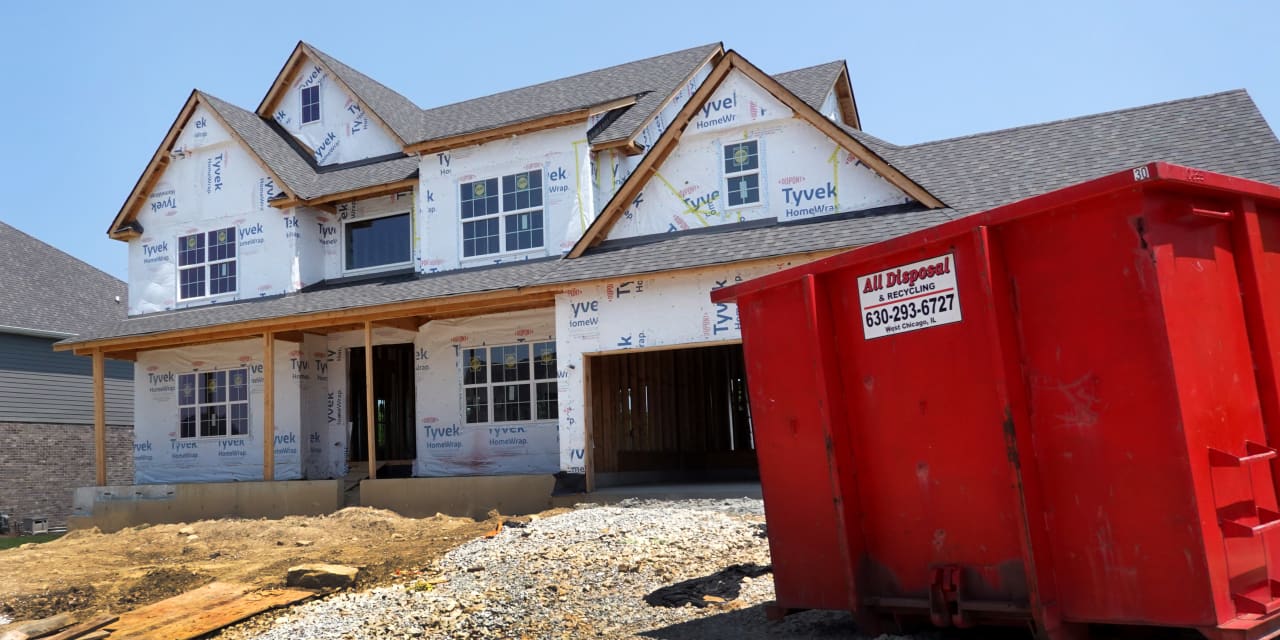Recent gains in mortgage rates may be a headwind for the housing market.
Scott Olson/Getty Images
Shares of public home builders broadly sank on Monday as Treasury yields rose. It was a pessimistic start to the fourth quarter following late-summer losses.
Builder stocks broadly dropped in the third quarter as quick-rising mortgage rates spooked buyers, builders, and investors. And as home building enters its typical slow season, the trajectory of mortgage rates remains a major headwind—but a long-term case for the stocks remains.
Mortgage rates ended the third quarter at a more than two-decade high, according to
Freddie Mac’s
closely-watched weekly gauge, with the average 30-year fixed mortgage rate increasing last week to 7.31%. The gains come as investors updated their expectations for inflation and the economy, sending the 10-year Treasury yield, with which mortgage rates often move, higher.
Such gains have added to the cost of financing a home purchase, putting renewed pressure on prospective buyers—and, by extension, home builders. The National Association of Home Builders’ gauge tracking industry confidence fell into negative territory last month, in part due to higher rates, while contract signings to buy new homes fell more than expected in August.
“Sales weakened in August with average mortgage rates above 7%,” National Association of Home Builders chief economist Robert Dietz wrote late last month. “While some builders were able to offset that effect via mortgage rate buydowns, rates moved higher this month, suggesting the pace of new home sales will weaken further for September.”
Mortgage rates could continue to rise. The 10-year Treasury yield rose to 4.682% on Monday, its highest 3 p.m. yield since October 2007, according to Dow Jones Market Data. Lawrence Yun, the National Association of Realtors’ chief economist, said last month that mortgage rates could rise as high as 8% in the near-term.
For investors in home builders, recent housing news and stock performance could feel like déjà vu. All of the 13 traditional home builder stocks in the
SPDR S&P Homebuilders ETF
(ticker: XHB) fell in the third quarter, according to FactSet data, with the stocks dropping an average 12%. It was the first losing period for builders since the same quarter last year, when builder stocks continued a selloff that began as mortgage rates rose significantly over the summer.
UBS
analysts John Lovallo, Spencer Kaufman, and Matthew Johnson reduced their price targets on home builders by an average 8% on Monday, citing higher interest rates, macroeconomic uncertainty, and lower investor sentiment.
Economists and analysts expect relatively high mortgage rates to stick around a while.
Fannie Mae
‘s September housing forecast anticipates rates to average 7.1% at the end of 2023, and fall to an average 6.3% by the end of 2024.
Similarly,
Goldman Sachs
analysts Vinay Viswanathan and Roger Ashworth upwardly revised their expectations for mortgage rates through the end of next year in a report last week. The analysts expect mortgage rates to end 2023 at 7.1%, and 2024 at 6.8%, up from previous estimates of 6.6% and 5.9%, respectively, and reduced their forecasts for 2024 mortgage origination volume to $1.35 trillion from $1.5 trillion.
The recent gains in mortgage rates may be a headwind for the housing market—but builders could once again spur demand by offering perks to would-be buyers, according to UBS. “If demand stalled we would expect increased incentives […] to reignite activity similar to what occurred in late 2022/early 2023,” the UBS analysts wrote.
The group’s relative outperformance this year could result in choppy near-term trading, the analysts added. Despite the shares’ third-quarter performance, the 13 builders in the SPDR Homebuilders ETF remained positive on the year, with an average increase of 50%, according to FactSet.
The long-term case for builder shares remains, the UBS analysts added. They said the U.S. housing market is under-built, adding that high mortgage rates continue to incentivize homeowners with ultralow rates to remain in place, reducing the selection of previously owned homes available for sale and directing demand toward builders.
Public builders have better access to land, labor, materials, and financing than private companies, the analysts wrote.
“As a result, we expect the public builders to remain prime beneficiaries in this fairly differentiated housing cycle.”
Write to Shaina Mishkin at [email protected]
Read the full article here










